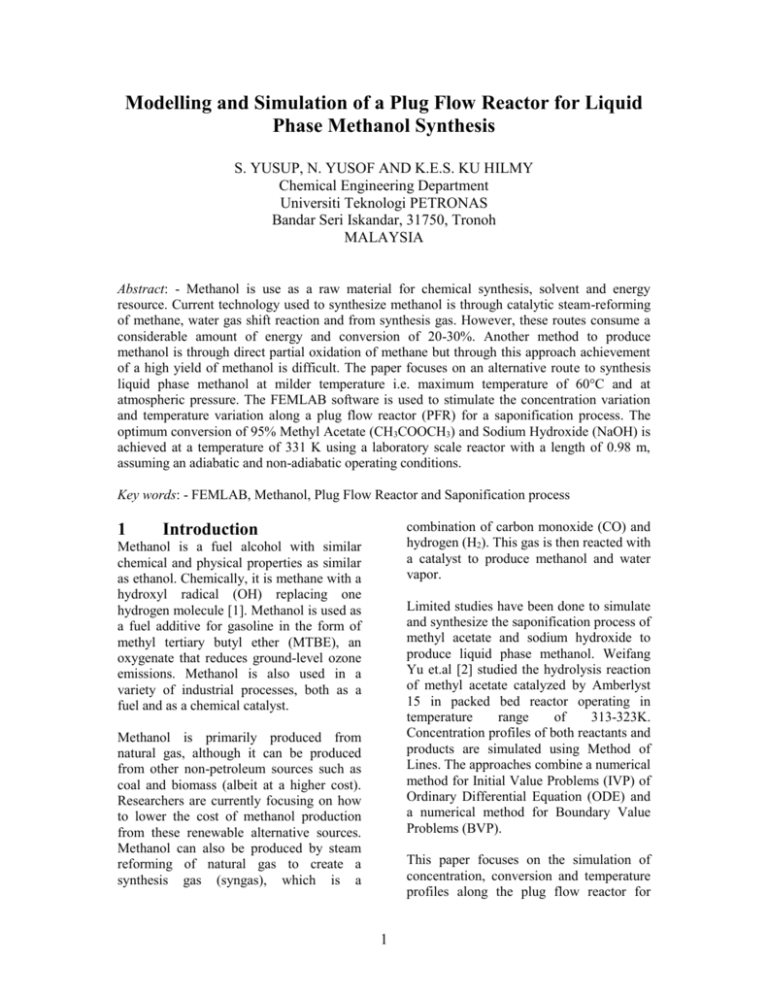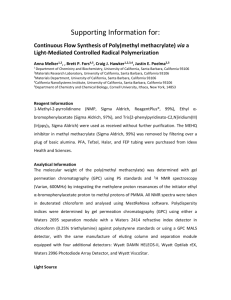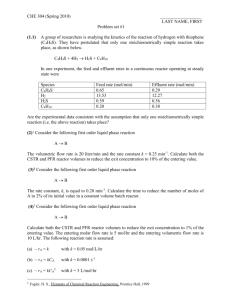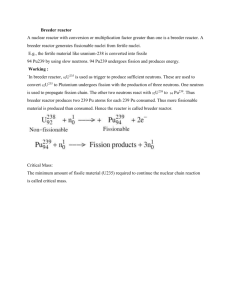Evaluation of a Plug Flow Reactor Performance for
advertisement

Modelling and Simulation of a Plug Flow Reactor for Liquid Phase Methanol Synthesis S. YUSUP, N. YUSOF AND K.E.S. KU HILMY Chemical Engineering Department Universiti Teknologi PETRONAS Bandar Seri Iskandar, 31750, Tronoh MALAYSIA Abstract: - Methanol is use as a raw material for chemical synthesis, solvent and energy resource. Current technology used to synthesize methanol is through catalytic steam-reforming of methane, water gas shift reaction and from synthesis gas. However, these routes consume a considerable amount of energy and conversion of 20-30%. Another method to produce methanol is through direct partial oxidation of methane but through this approach achievement of a high yield of methanol is difficult. The paper focuses on an alternative route to synthesis liquid phase methanol at milder temperature i.e. maximum temperature of 60°C and at atmospheric pressure. The FEMLAB software is used to stimulate the concentration variation and temperature variation along a plug flow reactor (PFR) for a saponification process. The optimum conversion of 95% Methyl Acetate (CH3COOCH3) and Sodium Hydroxide (NaOH) is achieved at a temperature of 331 K using a laboratory scale reactor with a length of 0.98 m, assuming an adiabatic and non-adiabatic operating conditions. Key words: - FEMLAB, Methanol, Plug Flow Reactor and Saponification process 1 combination of carbon monoxide (CO) and hydrogen (H2). This gas is then reacted with a catalyst to produce methanol and water vapor. Introduction Methanol is a fuel alcohol with similar chemical and physical properties as similar as ethanol. Chemically, it is methane with a hydroxyl radical (OH) replacing one hydrogen molecule [1]. Methanol is used as a fuel additive for gasoline in the form of methyl tertiary butyl ether (MTBE), an oxygenate that reduces ground-level ozone emissions. Methanol is also used in a variety of industrial processes, both as a fuel and as a chemical catalyst. Limited studies have been done to simulate and synthesize the saponification process of methyl acetate and sodium hydroxide to produce liquid phase methanol. Weifang Yu et.al [2] studied the hydrolysis reaction of methyl acetate catalyzed by Amberlyst 15 in packed bed reactor operating in temperature range of 313-323K. Concentration profiles of both reactants and products are simulated using Method of Lines. The approaches combine a numerical method for Initial Value Problems (IVP) of Ordinary Differential Equation (ODE) and a numerical method for Boundary Value Problems (BVP). Methanol is primarily produced from natural gas, although it can be produced from other non-petroleum sources such as coal and biomass (albeit at a higher cost). Researchers are currently focusing on how to lower the cost of methanol production from these renewable alternative sources. Methanol can also be produced by steam reforming of natural gas to create a synthesis gas (syngas), which is a This paper focuses on the simulation of concentration, conversion and temperature profiles along the plug flow reactor for 1 saponification process under both adiabatic and non-adiabatic operating conditions using FEMLAB version 3.0. Through modeling and simulation studies, better insight of reactor performance is possible. The experimental work would offer an alternative approach to synthesis liquid phase methanol through saponification process. 2 -rA = CAO (dXA/dt) = k (CAO-CAOXA) (CBO-CAOXA) Letting M = CB0/CA0 be the initial molar ratio of the reactant, equation (3) can be obtained. rA C AO dX A 2 kCAO (1 X A )( M X A ) dt (3) Integration of equation (3) results in equation (4). Theoretical Background XA 2.1 (2) Saponification Process 0 The hydrolysis of an ester in a base is called saponification process [3]. The reaction to produce methanol is as following: t dX A C AO k dt (1 X A )( M X A ) o (4) The simplified version of equation (4) is shown in equation (5) ln NaOH CH 3COCH 3 CH 3CONa CH 3OH C C 1 X B M XA ln ln B BO 1 X A M (1 X B ) CBC A (5) C AO ( M 1)kt (C BO C AO )kt Ester hydrolysis in base is called saponification as shown in the expression below. In a plug flow reactor, the composition of the fluid varies from point to point along a flow path [5]. The material balance for a reaction component for reactant A is shown as in equation (6). RCOR ' HO RCO R' OH 2.2 Adiabatic Plug Flow Reactor The stoichiometric equation for an Irreversible Bimolecular-Type Second Order Reaction is as shown below [4]; A B Pr oducts With corresponding rate equation as in equation (1) rA dC A dC B kCAC B dt dt FA ( FA dFA ) (rA )dV (6) From differentiation of equation equation (7) can be obtained. (6), FAO dX A (rA )dV (7) 2.3 Non-Adiabatic Reactor (1) Plug Flow For a non-adiabatic plug flow reactor, Q = Cp” (T2-T1) XA +Cp’ (T2-T1) (1-XA) + Noting that the amounts of A and B that have reacted at any time t are equal and given by CA0XA, where XA is the conversion of the reactant A, the equation is further simplified as in equation (2) △Hr1XA (8) Since, T H r1 H rO C p dT TO 2 (9) Combining equation (8) and (9) will give results in equation (10). XA C p ' T The transient temperature profiles and concentration profiles inside the plug flow reactor are initially solved using explicit finite difference method. FEMLAB program is utilized to obtain the insights of the problem. The main advantage of FEMLAB is that the equations can be expressed algebraically in terms of finite differences equations. The two modes in FEMLAB were developed to calculate and display the result for two dimensional (2D) transient temperature profiles and concentration profiles inside the reactor. The first mode is Convection-Diffusion and second mode is Conduction. The program will solve the temperature and concentration variation inside the reactor. The temperature and concentration value along the length of the reactor are iteratively calculated using the Partial Differential Equation. The flow diagram for this function program is as shown in Figure 2 below: (10) H r 2 Figure 1 shows the schematic diagram of a tubular reactor with heat exchanger. Ta FA0 FAe Te T0 V q= Ua (Ta-T) V+△V Figure 1: Heat transfer between reactor and heat exchanger Assuming a steady state condition, the following equations (11)-(15) are referred [6]. Q – Ws- FA0 n Start T Cp dt i i - [△H0R(TR) Define Geometry i 1 Ti 0 T + CpdT ]F A0X =0 Input Parameter Values (11) TR dQ - [FA0 ( dV Choose Application Mode dT iCpi + X△Cp)] dV - Define Boundary Settings and Sub-domains Setting for each Mode T dX (△H0R(TR) + CpdT ) FA0 =0 dV TR (12) dQ = Ua (Ta-T) dV (13) Refine Mesh Mode Display Graphical Results No Since: dX -rA= FA0 dV (14) rA dX = = f(X, T) FA 0 dV (15) 3.0 Display Concentration or Temperature Profile Yes End Figure 2: Procedure Identification Methodology 3 One of the important advantages of using FEMLAB in engineering application is the availability of the built in function in each application mode. In this work, the Convection-Diffusion Mode and Conduction-Convection Mode are applied in solving transient heat and diffusion of reactants. Diffusion Mode Boundary Boundary Condition Condition Equation n.Dc qc g Inward Flux Impervious or n. Dc = 0 Symmetry Concentration c=c0 Zero c=0 Concentration Heat transfer is the common denominator of most multiphysics problems. Heat transfer is governed by the heat equation as in equation (16). C T .(kT ) Q t Available as post processing variables are the concentration c, the concentration gradient, the diffusive flux and the normal component of diffusive flux. Also available is the source Q. The correlation velocity profile within the plug flow reactor is as shown in equation (18) [5]. (16) The thermal conductivity can be anisotropic, in which case k is a matrix. The heat transfer application mode models the heat equation. vz 4 vz r 1/7 and 1 vz , max 5 R vz, max (104 < re < 105) Diffusion processes are governed by the same equation as heat transfer. Thus, the generic diffusion equation has the same structure as the heat equation as shown in equation (17). c D c Q t (18) 4.0 Results and Discussions 4.1 Adiabatic Plug Flow Reactor (17) 4.1.1 Concentration Profile Figures 3 and 4 show the variation of concentration reactant along the length of the reactor. Sodium hydroxide and methyl acetate react along plug flow reactor to form sodium acetate and methanol. The reactant concentration starts to decrease from 100 moles/l to around 5 moles/l and, the product starts increases from 0 moles/l to 95 moles/l. The diffusion process can be anisotropic, in which case D is a matrix. The diffusion equation is modeled in the Diffusion application mode. The boundary conditions for heat transfer and diffusion mode are shown as in Table 1. Table 1: Boundary Conditions Heat Transfer Mode Boundary Boundary Condition Condition Equation Heat Flux n.(-kT) = q + h(Tinf – T) Sources + Cconst (T4amb – T4) Insulation or n.kT 0 Symmetry Temperature T=T0 Antisymmetry T = 0 4 Concentration (moles/l) Specific Heat (J/mol.K) Reaction Rate Constant, k (mol.s/m3)-1 Maximum Velocity (m/s) Length, L 152 2.9E-3 Vo/(3.1R2) 1.4 When the initial concentration of reactants increased or decreases conversion profile of reactant to products along the length of plug flow reactor would also be affected. Figure 5 shows the effect of varying the initial concentration of reactants on conversion profile. Length of Reactor (m) Figure 3: Solve Mode for Adiabatic Plug Flow Reactor Effect of initial concentration 1 Length Vs Concentration 0.9 Concentration (mol/l) 100 0.8 90 0.7 80 Conversion 0.6 70 Reactant: NaOH, MeAc 60 CA0 = 100 moles/l CA0 = 50 moles/l CA0 = 200 moles/l 0.5 0.4 Product: Methanol, NaAc 50 0.3 40 0.2 30 0.1 20 0 0 10 0.2 0.4 0.6 0.8 1 1.2 1.4 Length (m) 0 0 0.1 0.2 0.3 0.4 0.5 0.6 0.7 0.8 0.9 1 1.1 1.2 1.3 1.4 Figure 5: Effect of Initial Concentration of Reactants to Conversion 1.5 Length (m) Figure 4: Concentration of Reactant and Product vs. Length of Reactor From Figure 5, it is observed that as initial concentration of the reactant increases, the conversion of the methyl acetate to methanol also found to increase up to approximately 95%. 4.1.2 Effects of Various Initial Concentration of Methyl Acetate on Conversion of Reactants Various concentrations of Methyl Acetate and Sodium Hydroxide were used to study the effect of different concentrations to conversion of reactants along the length of the plug flow reactor. The initial values of some constant that were used for the modeling is as shown in Table 2: 4.1.3 Effects of Various Flow Rates of Methyl Acetate on Conversion of Reactants Various flow rates of Methyl Acetate and Sodium Hydroxide were used to study the effect of different flow rate to conversion of methyl acetate along the length of plug flow reactor as shown in Table 3. Table 2: Values for Constant Parameters Constant Parameters Inlet Temperature, To (K) Total Volumetric Flow Rate, VO (m3/s) Heat of Reaction,∆Hrx (J/mol.K) Thermal Conductivity, k (W/m.K) Radius, R (m) Density, ρ (kg/m3) Value 298 0.0005 Table 3: Flow rate of Reactants Flow rate Normal Increase Decrease -80929 0.649 0.1 1510 5 Value (m3/s) 0.0005 0.001 0.00025 Conversion Vs Length Bt Modeling and Experiment Effect of flowrate 1 1 0.9 0.9 0.8 0.8 0.7 0.7 Conversion 0.6 Average flowrate Increase flowrate Decrease flowrate 0.5 Modeling Experiment 0.5 0.4 0.4 0.3 0.3 0.2 0.2 0.1 0.1 0 0 0 0.2 0.4 0.6 0.8 1 1.2 1.4 1.6 Length (m) 0 0.2 0.4 0.6 0.8 1 1.2 1.4 1.6 Length (m) Figure 8: Comparison the conversion of Methyl Acetate and Sodium Hydroxide between modeling and empirical method Figure 6: Effect of Flow Rate on the Conversion of Methyl Acetate and Sodium Hydroxide Figure 8 shows the comparison between modeling and experimental data. Similar profiles of methyl acetate conversion were observed between experimental and modeling method. Both approaches give 95% of reaction final conversion. Hence it can be concluded that finite element method using FEMLAB can produce the conversion and temperature profiles along the plug flow reactor effectively. Figure 6, shows that changes in initial flow rate will affect the conversion of reactants to the products. Increased flowrate results in increased value of conversion up to approximately 95%. The effect of varying the flowrate was apparent up to reactor length of 0.4 m. Beyond this; varying flowrate does not affect the conversion obtained. 4.1.4 Effects of Various Initial Temperature of Methyl Acetate to Conversion of Reactants Figure 7 shows the effect of varying the initial temperature on conversion of reactants to product. The temperature ranges are 288K, 298K and 308K. The conversion of reactants was found to increase with temperature. 4.2 Non-Adiabatic Reactor Plug Flow For a non-adiabatic system, the plug flow reactor is enveloped with a cooling water system. Figures 9-11 show the concentration profiles of the reactants along the non-adiabatic reactor. Concentration (moles/l) Effect of temperature 1 0.9 0.8 0.7 0.6 Conversion Conversion 0.6 Increase T0 T0 = 298 Decrease T0 0.5 0.4 0.3 0.2 0.1 0 0 0.2 0.4 0.6 0.8 1 1.2 1.4 1.6 Length of Reactor (m) Length (m) Figure 7: Effect on Initial Temperature of Reactants to the Conversion of Reactants Figure 9: Solve mode of reactant concentration for non-adiabatic reactor 6 Concentration (moles/l) The maximum value of conversion achieved is 80% that is lower than the conversion obtained in adiabatic reactor due to the heat removal from the reactor. Length of Reactor (m) Figure10: Concentration of reactant profile Length Vs Concentration with HE 100 Figure 13: Solve mode for temperature in non-adiabatic reactor 90 80 Concentration (mol/l) 70 60 Figures 13-15 shows the temperature profiles of the reactants along the plug flow reactor operating under non-adiabatic operating conditions. Reactant: NaOH, MeAc 50 Product: NaAc, Methanol 40 30 20 10 0 0 0.1 0.2 0.3 0.4 0.5 0.6 0.7 0.8 0.9 1 1.1 1.2 1.3 1.4 Length (m) Temperature (K) Figure 11: Concentration profiles in nonadiabatic reactor The reactant concentration was found to decrease from 100 moles/l to around 20 moles/l whereas the concentration of product starts to increase from 0 moles/l to 80 moles/l. Length of Reactor (m) Length Vs Conversion with HE 0.9 Figure 14: Temperature Profile of Reactants in Non-Adiabatic reactor 0.8 0.7 0.5 0.4 Temperature (K) Conversion 0.6 0.3 0.2 0.1 0 0 0.1 0.2 0.3 0.4 0.5 0.6 0.7 0.8 0.9 1 1.1 1.2 1.3 1.4 Figure 16: Temperature of Heat Exchanger Length (m) Figure 12: Conversion profile of reactants in non-adiabatic reactor The corresponding conversion profiles for methyl acetate are shown as in Figure 12. Length of Reactor (m) Figure 15: Temperature of Heat Exchanger 7 5.0 T Ua Conclusion The optimum conversion of methyl acetate to produce liquid phase methanol is found to be 95% at a temperature of 331K with reaction condition of RCOR’:OH-=1:1 and pressure of 1 atm using a laboratory scale for both modeling and experiment values. From this project it can be concluded that FEMLAB can effectively predict both the concentration and conversion profile of reactant along plug flow reactor for both adiabatic and non-adiabatic operating conditions. In addition, visualization of concentration profile of reactants and product within the reactor is possible using FEMLAB. The developed programmed allows prediction of both temperature and conversion profiles for a larger scale reactor. It is further recommended to extend the capability of the developed simulation by incorporating the variation of yield. V Vo Vz Ws X ΔHr ΔCp ρ Temperature (K) Overall heat transfer coefficient (W/m2.K) Volume of reactor (m3) Total volumetric flowrate (m3/s) Average velocity (m/s) Work done on the reacting fluid (J) Conversion of reactant Heat of reaction at temperature T Heat Capacity (J/mol.K) Density (kg/m3) Subscript: A Methyl Acetate B Sodium Hydroxide o Initial condition e Exit condition References: [1] Francis A. Carey,Organic Chemistry, 4th Edition, McGraw Hill, 1990. [2] Weifang Yu, K.Hidajat and Ajay K.Ray, Determination of adsorption and kinetic parameters for methyl acetate esterification and hydrolysis reaction catalyzed by Amberlyst 15, Applied Catalysis A, pg 1-22. [3] Robert H.Perry, Don W. Green, Perry Chemical Engineering’s Handbook, 7th Edition, McGraw Hill. [4] Octave Levenspiel, Chemical Reaction Engineering, 3rd Edition, John Wiley & Sons, Inc., 1990. [5] Fogler H. S., Elements of Chemical Reaction Engineering, Prentice Hall, 1999. [6] R. Byron Bird, Warren E. Stewart, Edwin N. Lightfoot, Transport Phenomena, 2nd Edition, John Wiley & Sons, Inc., 2002. Acknowledgement: The author would like to acknowledge Ministry of Science, Technology and Innovation (MOSTI) for granted IRPA grant number 09-999-02-10001 EAR to support the research and Universiti Teknologi PETRONAS for permission to attend the conference. Nomenclature: C Concentration (mol/m3) Cp Heat capacity (J/mol.K) Cp’ Mean specific heat of un-reacted feed stream (J/mol) Cp” Specific heat of completely converted product stream (J/mol) F Molar flowrate (mol/s) k Reaction rate constant k Thermal conductivity (W/m.K) k Heat transfer coefficient (W2/m.K) M Molar ratio Q Total heat (J) R,r Radius (m) -r Rate of reaction Re Reynold number t Time (s) 8









